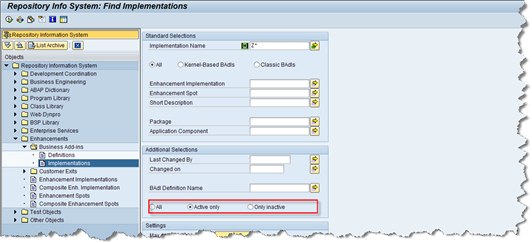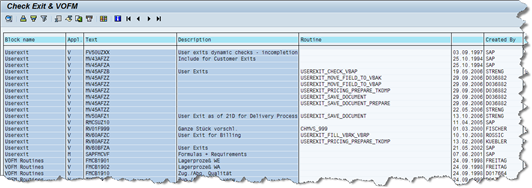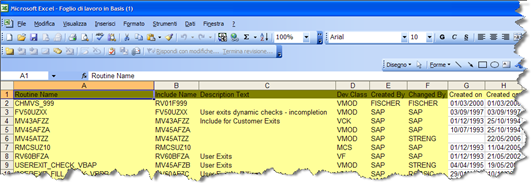
- SAP Community
- Groups
- Interest Groups
- Application Development
- Blog Posts
- How many exit routines are active in your SAP ERP ...
- Subscribe to RSS Feed
- Mark as New
- Mark as Read
- Bookmark
- Subscribe
- Printer Friendly Page
- Report Inappropriate Content
See the UPDATES section below for change log

Let's check with X-it RAY Eye
In all upgrade projects in which I was involved I prepared a checklist of standard modifications and implemented userexits.
This kind of analysis performed before the upgrade, as well as give an overview of the system complexity, is helpful to prepare the testing sessions and identify a dangerous situations such as the missing call to an exit routine.
Standard tools?
The question is: how do I get a list of these customizations with minimal effort? Which are the available SAP tools?
The standard modifications can be identified using the transaction SE95 (Modification browser) that is, in my opinion, the most effective tool for this type of analysis.
But for the userexit? Is it possible to draw a map of all exit routines active in SAP ERP before an Upgrade ?

There are different types of exits in an ERP system and many tools that you can use to perform an analysis, but the result can not be achieved in a short time ...
Let’s start with the cataloguing ...
Userexits and VOFM Routines
The Modification browser is helpful if you have to look up at the implementations of include Userexits and VOFM Routines

It's not a simple task, but it is better than search the userexits among the transport requests or recognize “custom” VOFM form routines by browsing directly in the transaction VOFM...
Inside transaction VOFM you have to:
Select the Category Group

Select the Custom Routine...

and finally access to the source code

Field-Exits
Fortunately for the Field-Exits the manual effort is reduced to the minimum because there is the standard report RSMODPRF

The function key "Edit FM" allows to access directly to the source code

Validations and Substitutions Exits
Managing the Validation Exit and the Substitution Exit from the maintenance transactions can become extremely boring!!!
It is necessary to explode all validation/substitution steps 'till you find a step that contains an exit routine...

Otherwise, there are reports RGUGBR31 (Validation Directory) and RGUGBR32 (Substitution Directory) but they are not interactive reports

So the formpool must be determined into the view V_T80D

Customer Exits, Screen Exits and Menu Exits
Customer Exit, Screen Exit and Menu Exit are managed by transaction CMOD where the situation is slightly better.
Again, in order to access to the source code of the exit many steps are required.
First of all you need to select the active projects; so from CMOD transaction select in the menu: GOTO -> FIND

Then deselect the "Inactive" enhancement component checkbox

and for each project selected you have to jump to the assigned components and to the implementations
Select the project...

Access to the components list...

And then jump to the implementation...


Business Transaction Events (BTEs)
Active Business Transaction Events can be reached by transaction BERE but again many steps are required!
Run the report with the checkbox "Only BTEs with active Products" selected...

Then select the event from the list...

and finally check whether the active component has inside custom elements...

Last but not least BAdI Implementations.
The Modification Browser transaction (SE95) returns the list of BAdI implementations regardless of activation status (On/Off) but I personally prefer the Respository Browser (SE84) because is possible to select "Only Active" implementations

The selection result...

double-click to browse the implementation...

I would like an ABAP that...
Customers and colleagues often asked me if I knew a single tool that lists all the active userexits. I always answered no, proposing as approach the list of steps shown above.
Across the years I have tried to collect and automate (the first version dates back to the release 3.1I) every step of analysis in an ABAP program, but I never had time to optimize the code, so I always quickly adapted the same source to the various releases, making it unreadable and impossible to share.

One day my colleague sergio.ferrari2 (SAP Mentor Alumni) asked me: "Hey Andrea, why don't you take a look to the Abap SNIF?"
I must be honest, I understood everything by that name...
What's SNIF?
Finally the SAP has developed a kind of "Exit Browser" that avoids launching dozen of transactions in the system (excluding the various checks).
I investigated thru the implementation of this program concluding that even if the idea is wonderful and the program is useful it could be enhanced to include other type of exits And now I’m glad to share with the great SDN Community my own extended version of the SNIF that detects all types of missing exits.
X-it RAY EYE was born
X-it RAY Eye means ... X-Ray Eye + X-it (= Exit) => X-it RAY Eye
Thus the abap that I would like to share in this blog is the "son" of the SNIF program, because it uses his "architecture" with the difference that extends the search to the following types of exit:
- Include USEREXITS
- VOFM Form Routines
- Exit for VALIDATIONS
- Exit for SUBSTITUTIONS
- SCREEN EXIT
- MENU EXIT
- CHANGED KEYWORDS
The ECC Version of X-it Ray Eye extends the search to the enhancement implementations:
- SOURCE CODE Enhancements
- FUNCTION Enhancements
- CLASS Enhancements
- BAdI Enhancements
Some of these items are not properly ABAP, however I've collected them in the tool.
Selection Screen:

Output results:

Navigation:

Download results in Excel:


I summarize briefly the main features:
- The X-it Scanner detects only the active implementations of existing exit routines developed in the customer name range with the exception of include userexits and Vofm routines
- For the VOFM routines the "customer" name range is determined by the group indicator
- The original section of the "BAPI usage" by custom programs has been removed
- In the X-it Scanner version for SAP R/3 Enterprise 4.7 and SAP ECC 5.0 the new concept of Enhancement introduced by ECC 6.0 is out of scope
- Original language: EN English
Out of Scope:
- Screen Variants & Transaction variants
Versions:
- ZSDN_EXIT_SCANNER for SAP R/3 Enterprise and SAP ECC 5.0
- ZSDN_EXIT_SCANNER60 for SAP ECC 6.0
Related Content
- guide - VOFM transaction
- Userexit in Validations and Substitutions Rules
- Enhancement Framework
- The new Enhancement Framework and the new kernel-based BAdI
Relevant SAP Notes
- 381348 - Using Userexit, Customer Exit, VOFM in SD
- 842318 - FAQs about validations + substitutions
- 356737 - Customer name range for VOFM routines
- 327220 - VOFM function and its objects
- 29377 - FAQs: Field exits (CMOD)
- 729358 - Display report to find active customer enhancements
Special thanks
I would like to thanks my colleagues @ Techedge:
sergio.ferrari2 (SAP Mentor Alumni) for his advices (Related Weblogs: how many lines of custom ABAP code are inside your system? )
and vincenzo.gala my friend and SAP Admin @ Bayer Business Solutions for his support during the unit test phase in rel. 4.7 Enterprise.
How to install?
Download the nugget file from here and import it in your SAP system using SAPLink.

Then goto your inactive object list and activate all objects

At last, run ZSDN_EXIT_SCANNER by SE38 and... Scan'em All!
I hope you like it.
UPDATES
9-Nov-2011 abapexitrayeye CodeExchange project born
29-Nov-2011 Check for the available releases at https://cw.sdn.sap.com/cw/releases/viewall/1212
29-Nov-2011 Please check the fixed issues section for solutions of little bugs
21-Jul-2015 I set up a repository in GitHub; you can download the ABAPexitrayeye here.
- SAP Managed Tags:
- ABAP Development
You must be a registered user to add a comment. If you've already registered, sign in. Otherwise, register and sign in.
-
A Dynamic Memory Allocation Tool
1 -
ABAP
8 -
abap cds
1 -
ABAP CDS Views
14 -
ABAP class
1 -
ABAP Cloud
1 -
ABAP Development
4 -
ABAP in Eclipse
1 -
ABAP Keyword Documentation
2 -
ABAP OOABAP
2 -
ABAP Programming
1 -
abap technical
1 -
ABAP test cockpit
7 -
ABAP test cokpit
1 -
ADT
1 -
Advanced Event Mesh
1 -
AEM
1 -
AI
1 -
API and Integration
1 -
APIs
8 -
APIs ABAP
1 -
App Dev and Integration
1 -
Application Development
2 -
application job
1 -
archivelinks
1 -
Automation
4 -
BTP
1 -
CAP
1 -
CAPM
1 -
Career Development
3 -
CL_GUI_FRONTEND_SERVICES
1 -
CL_SALV_TABLE
1 -
Cloud Extensibility
8 -
Cloud Native
7 -
Cloud Platform Integration
1 -
CloudEvents
2 -
CMIS
1 -
Connection
1 -
container
1 -
Debugging
2 -
Developer extensibility
1 -
Developing at Scale
4 -
DMS
1 -
dynamic logpoints
1 -
Eclipse ADT ABAP Development Tools
1 -
EDA
1 -
Event Mesh
1 -
Expert
1 -
Field Symbols in ABAP
1 -
Fiori
1 -
Fiori App Extension
1 -
Forms & Templates
1 -
IBM watsonx
1 -
Integration & Connectivity
10 -
JavaScripts used by Adobe Forms
1 -
joule
1 -
NodeJS
1 -
ODATA
3 -
OOABAP
3 -
Outbound queue
1 -
Product Updates
1 -
Programming Models
13 -
Restful webservices Using POST MAN
1 -
RFC
1 -
RFFOEDI1
1 -
SAP BAS
1 -
SAP BTP
1 -
SAP Build
1 -
SAP Build apps
1 -
SAP Build CodeJam
1 -
SAP CodeTalk
1 -
SAP Odata
1 -
SAP UI5
1 -
SAP UI5 Custom Library
1 -
SAPEnhancements
1 -
SapMachine
1 -
security
3 -
text editor
1 -
Tools
16 -
User Experience
5
| User | Count |
|---|---|
| 6 | |
| 5 | |
| 3 | |
| 3 | |
| 2 | |
| 2 | |
| 2 | |
| 2 | |
| 1 | |
| 1 |